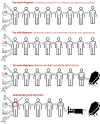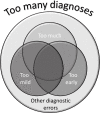Too Much, Too Mild, Too Early: Diagnosing the Excessive Expansion of Diagnoses
- PMID: 35966506
- PMCID: PMC9365059
- DOI: 10.2147/IJGM.S368541
Too Much, Too Mild, Too Early: Diagnosing the Excessive Expansion of Diagnoses
Abstract
Tremendous scientific and technological advances have vastly improved diagnostics. At the same time, false alarms, overdiagnosis, medicalization, and overdetection have emerged as pervasive challenges undermining the quality of healthcare and sustainable clinical practice. Despite much attention, there is no clarity on the classification and handling of excessive diagnoses. This article identifies three basic types of excessive diagnosing: too much, too mild, and too early. Correspondingly, it suggests three ways to reduce excess and advance high value care: we must stop diagnosing new phenomena, mild conditions, and early signs that do not give pain, dysfunction, and suffering.
Keywords: diagnosis; excess; expansion; overdiagnoses; overtreatment.
© 2022 Hofmann.
Conflict of interest statement
I certify that there is no conflict of interest in relation to this manuscript, and there are no financial arrangements or arrangements with respect to the content of this manuscript with any companies or organizations.
Figures




References
-
- World Health Organization. ICD-11 implementation or transition guide. Geneva: World Health Organization; 2019.
-
- World Organization of Family Doctors (WONCA) International Classification Committee. International Classification of Primary Care, ICPC-2; 1998.
-
- World Health Organization. International Classification of Functioning, Disability and Health: ICF. Geneva: World Health Organization; 2001.
LinkOut - more resources
Full Text Sources

